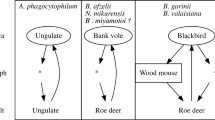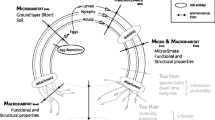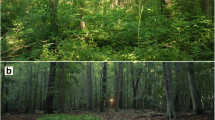Abstract
More than 19,000 human cases of Lyme disease (LD) are reported each year in the United States. Lyme disease cases occur when humans are exposed to the bacterium Borrelia burgdorferi through the bite of an infected ixodid tick. The probability of human exposure to infected ticks results from a combination of human behaviors and entomological risk. Human behaviors include use of tick habitats, use of protective clothing, and grooming for tick removal. Entomological risks include the density of ticks in a habitat and the proportion of these that are infected with B. burgdorferi. Recent studies have suggested that humans are at higher risk of exposure to B. burgdorferi near edges between forests and herbaceous communities, including lawns and old fields, but whether this increased risk is a function of human behaviors, entomological risk, or both, is unknown. We assessed entomological risk across forest–old field edges in Dutchess County, NY. Densities of ticks and of infected ticks were considerably higher within forests than at forest–field edges, and were lowest within fields. Thus, edges between forests and fields do not pose a higher entomological risk than do the forests themselves, although risk at the edge is higher than in herbaceous habitat. Landscapes with abundant edges between forested and herbaceous habitat, and roughly even proportions of both, might attract both heavy human use and pose moderately high entomological risk, and thus could be targeted for mitigation. We suggest that determining appropriate methods for reducing human exposure to LD requires differentiating entomological risk from human behaviors.




Similar content being viewed by others
References
Adler GH, Telford SR III, Wilson ML, Spielman A (1992) Vegetation structure influences the burden of immature Ixodes dammini on its main host, Peromyscus leucopus. Parasitology 105:105–110
Barbour AG, Fish D (1993) The biological and social phenomenon of Lyme disease. Science 260:1610–1616
Cadenasso ML, Traynor MM, Pickett STA (1997) Functional location of forest edges: gradients of multiple physical factors. Canadian Journal of Forest Research 27:774–782
Centers for Disease Control and Prevention (CDC) (2004) Lyme disease— United States, 2001–2002. MMWR. Morbidity and Mortality Weekly Report 53:365–369
Das A, Lele SR, Glass GE, Shields T, Patz J (2002) Modelling a discrete spatial response using generalized linear mixed models: application to Lyme disease vectors. International Journal of Geographical Information Science 16:151–166
Dinser R, Jendro MC, Schnarr S, Zeidler H (2005) Antibiotic treatment of Lyme borreliosis: what is the evidence? Annals of Rheumatic Diseases 64:519–523
Dister SW, Fish D, Bros SM, Frank HD, Wood BL (1997) Landscape characterization of peridomestic risk for Lyme disease using satellite imagery. American Journal of Tropical Medicine and Hygiene 57:687–692
Duffy DC, Clark DD, Campbell SR, Gurney S, Perello R, Simon N (1994) Landscape patterns of abundance of Ixodes scapularis (Acari, Ixodidae) on Shelter Island, New York. Journal of Medical Entomology 31:875–879
Falco RC, Fish D (1992) A comparison of methods for sampling the deer tick, Ixodes dammini, in a Lyme disease endemic area. Experimental and Applied Acarology 14:165–173
Frank DH, Fish D, Moy FH (1998) Landscape features associated with Lyme disease risk in a suburban residential environment. Landscape Ecology 13:27–36
Jackson LE, Hilborn ED, Thomas JC (2006) Towards landscape design guidelines for reducing Lyme disease risk. International Journal of Epidemiology 35:315–322
Markowski D, Ginsberg HS, Hyland KE, Hu R (1998) Reservoir competence of the meadow vole (Rodentia: Cricetidae) for the Lyme disease spirochete Borrelia burgdorferi. Journal of Medical Entomology 35:804–808
Mather TN (1993) The dynamics of spirochete transmission between ticks and vertebrates. In: Ginsberg HS (editor), Ecology and Environmental Management of Lyme Disease New Brunswick, NJ: Rutgers University Press, pp 43–60
Maupin GO, Fish D, Zultowsky J, Campos EG, Piesman J (1991) Landscape ecology of Lyme disease in a residential area of Westchester County, New York. American Journal of Epidemiology 133:1105–1113
Morris DW (1991) Fitness and patch selection by white-footed mice. The American Naturalist 138:702–716
Murcia C (1995) Edge effects in fragmented forests: implications for conservation. Tree 10:58–62
Orloski KA, Hayes EB, Campbell GL, Dennis DT (2000) Surveillance for Lyme disease—United States, 1992–1998. MMWR. Morbidity and Mortality Weekly Report 49(SS03):1–11
Ostfeld RS, Hazler KR, Cepeda OM (1996) Temporal and spatial dynamics of Ixodes scapularis (Acari: Ixodidae) in a rural landscape. Journal of Medical Entomology 33:90–95
Ostfeld RS, Keesing F (2000) The function of biodiversity in the ecology of vector-borne zoonotic diseases. Canadian Journal of Zoology 78:2061–2078
Ostfeld RS, Price A, Hornbostel V, Benjamin M, Keesing F (2006) Controlling ticks and tick-borne zoonoses with biological and chemical agents. BioScience 56:383–394
Piesman J, Mather TN, Dammin GJ, Telford SR III, Lastavica CC, Spielman A (1987) Seasonal variation of transmission risk of Lyme disease and human babesiosis. American Journal of Epidemiology 126:1187–1189
Schmidtmann ET, Carroll JF, Potts WJE (1994) Host-seeking of blacklegged tick (Acari: Ixodidae) nymphs and adults at the woods-pasture interface. Journal of Medical Entomology 31:291–296
Stafford KC, Magnarelli LA (1993) Spatial and temporal patterns of Ixodes scapularis (Acari, Ixodidae) in Southeastern Connecticut. Journal of Medical Entomology 30:762–771
Van Buskirk J, Ostfeld RS (1998) Habitat heterogeneity, dispersal, and local risk of exposure to Lyme disease. Ecological Applications 8:365–378
Williams-Linera G (1990) Vegetation structure and environmental conditions of forest edges in Panama. Journal of Ecology 78:356–373
Acknowledgments
The authors thank the National Science Foundation (REU program and Ecological Biology program) and the National Institutes of Health (NIAID) for funding this research. Ray Winchcombe and Kelly Oggenfuss provided crucial logistical support. This is a contribution to the program of the Institute of Ecosystem Studies.
Author information
Authors and Affiliations
Corresponding author
Rights and permissions
About this article
Cite this article
Horobik, V., Keesing, F. & Ostfeld, R.S. Abundance and Borrelia burgdorferi-infection Prevalence of Nymphal Ixodes scapularis Ticks along Forest–Field Edges. EcoHealth 3, 262–268 (2006). https://doi.org/10.1007/s10393-006-0065-1
Published:
Issue Date:
DOI: https://doi.org/10.1007/s10393-006-0065-1




